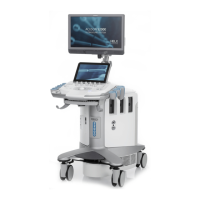2 Safety and Care
Instructions for Use 2 - 13
Biohazard Considerations
WARNING: With the exception of systems licensed to use the ACUSON AcuNav catheter, this
equipment is not suitable for intracardiac use or direct cardiac contact.
See also: For additional information on the AcuNav catheter, refer to the user manual for the
catheter.
WARNING: This equipment is not suitable for intracardiac use or direct cardiac contact.
WARNING: For neonatal head imaging, Siemens recommends that you exercise special care
during neonatal cephalic scanning to avoid possible damage to the posterior region of the eye.
The ultrasound energy emitted by the transducer easily penetrates the fontanels of the infant.
WARNING: Siemens makes every effort to manufacture safe and effective transducers. You
must take all necessary precautions to eliminate the possibility of exposing patients, operators,
or third parties to hazardous or infectious materials. These precautions should be considered in
the use of any application that may indicate the need for such care, and during endocavity or
intraoperative scanning; during biopsy or puncture procedures; or when scanning patients with
open wounds.
WARNING: To eliminate the possibility of exposing patients, operators, or third parties to
hazardous or infectious materials, always dispose hazardous or infectious materials according to
local, state, and regional laws and regulations.
WARNING: Transducer sheaths: There have been reports of severe allergic reactions to
medical devices containing latex (natural rubber). Health care professionals are advised to
identify latex-sensitive patients and to be prepared to treat allergic reactions promptly. For
additional information in the U.S.A., refer to FDA Medical Alert MDA91-1.
WARNING: Ultrasound energy is transmitted more effectively through water than through tissue.
When using a standoff device of any kind, for example, a waterpath or gel pad, the actual
mechanical and thermal indices, MI and/or TI, may be higher than indicated in the output display
on the ultrasound system.
The assessment of the biological effects of diagnostic ultrasound on humans is a subject of
ongoing scientific research. This ultrasound system, and all diagnostic ultrasound procedures,
should be used for valid reasons, for the shortest possible period of time, and at the lowest
mechanical and thermal indices necessary to produce clinically acceptable images.
According to the principles of ALARA (As Low As Reasonably Achievable), the acoustic output
should be the lowest level required to satisfactorily perform the examination.
The ultrasound imaging system complies with the standards of the American Institute of
Ultrasound in Medicine (AIUM) and the National Electrical Manufacturer's Association (NEMA),
the guidelines of the United States Food and Drug Administration (FDA) and the standards of
the International Electrotechnical Commission (IEC) in terms of safety and acoustic output
levels. The ultrasound output levels are stated to permit the user to critically evaluate the
ultrasound system settings in the event of new research findings being announced.

